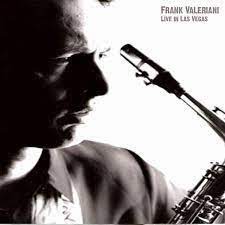
Daily Dose Of Jazz…
Frank J. Valeriani was born in Newark, New Jersey on November 26, 1966. He started studying saxophone at age of 15. When his family moved to Italy he put together his first mediterranean blues oriented band. While living in Italy he graduated magna cum laude from the music conservatory in Naples. After the conservatory years he started several bands, including jazz, fusion and latin jazz, and peformed at several festivals before moving north to Milano, Italy.
In Milano He studied songwriting, arranging and jazz at the alternative contemporary music school, Professional Music Center, graduating with excellent scores. During his Italian years he performed with Wess, Rocky Roberts, Cristiano Malgioglio, Peppino Gagliardi, Nello Daniele and others. He was music coordinator and conductor of the folk show Quanno Tramonta ‘o Sole that toured all over Italy for several years. He also toured with Maestro Gianni Mazza and performed on Italian tv networks.
Deciding to move back to the states he chose Las Vegas, Nevada for its musical activity. He performed with some of the best musicians in town, such as The Platters, The Drifters, jazz singers Nancy Kelly and Tony Bennett. Frank also performs with the Frank Valeriani Band all over the town.
He plays jazz, smooth jazz, and pop, doubles on percussion, rhythm guitar & keyboards and enjoys back up singing when required. As an educator he teaches saxophone and harmony in music schools. Saxophonist Frank Valeriani is also a composer and arranger and continues to perform and teach.
More Posts: arranger,bandleader,composer,history,instrumental,jazz,music,saxophone
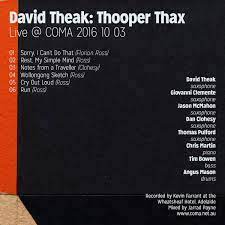
Daily Dose Of Jazz…
David Theak was born on November 10, 1970 in Sydney, New South Wales, Australia and was raised in a house of impromptu parties. His childhood found him listening to his downstairs neighbor teaching piano every afternoon which led to lessons and a piano for Christmas. His bandmistress at Mona Vale PS introduced him to the saxophone but paid his dues on the baritone horn for a couple of years. After a brief stint at the Conservatorium High School, he returned to the local high school with some enthusiastic music teachers. They encouraged us to improvise and created opportunities for us to play in jazz and rock bands.
he following years saw David practicing, composing, gigging, releasing his own albums and organizing tours of Australia & Europe for his quartet, theak-tet, but with limited opportunities in the 90’s, he became involved with a musician led organization, the Jazzgroove Association, which received NSW and Federal government funding that allowed presentation of new music every week as well as create a record label and form an original creative jazz orchestra, The Jazzgroove Mothership Orchestra.
He went on to become involved with SIMA, WAYJO and the formation of the Australian National Jazz Orchestra and ANJO Youth Big Band. David has been running a boutique international jazz festival for the past five years, is currently a Senior Lecturer in Jazz at the Sydney Conservatorium of Music, Artistic Director of the Australian National Jazz Orchestra, an advisory panel member of the Western Australian Youth Jazz Orchestra, President of the Sydney Improvised Music Association and Artistic Director of the Sydney Con Jazz Festival.
Jazz saxophonist, composer, bandleader, educator, festival director and jazz protagonist, David Theak, who continues to compose, perform and tour, is the artistic director of the Jazzgroove Mothership Orchestra and collaborates with a who’s who of international jazz musicians.
More Posts: bandleader,composer,educator,history,instrumental,jazz,music,saxophone
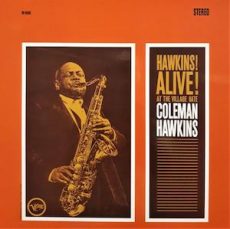
Requisites
Hawkins! Alive! At The Village Gate ~ Coleman Hawkins | By Eddie Carter
This morning’s choice from the library takes us to The Village Gate for two performances on August 13 and 15, 1962 by The Coleman Hawkins Quartet. Hawkins! Alive! At The Village Gate (Verve Records V-8509/V6-8509) hit the stores in 1963 and is the companion to Hawkins! Eldridge! Hodges! Alive! At The Village Gate. It was also recorded on August 15 with special guests Roy Eldridge and Johnny Hodges. Hawk was one of the greatest musicians during the Swing Era and a commanding presence on the tenor sax throughout his career. Hawk’s joined on stage by Tommy Flanagan on piano, Major Holley on bass, and Ed Locke on drums. My copy used in this report is the 1995 Classic Records US Stereo Audiophile reissue sharing the original catalog number.
Side One opens with All The Things You Are by Jerome Kern and Oscar Hammerstein II. Tommy lays the foundation on a concise introduction leading to Coleman’s melody and lively lead solo possessing one imaginative idea after another. Tommy matches him in agility on a spirited reading. Major follows with a splendid statement leading to Coleman’s return for the theme’s reprise. Hawkins introduces the next tune to the audience, the African American spiritual, Joshua Fit The Battle of Jericho. Hawk takes the lead on the theme, stepping aside for Flanagan who gives a marvelous first solo. Holley makes his presence felt on a strong, personal interpretation vocally accompanying his bass playing. Hawkins puts an exclamation point on the finale preceding the group’s climax.
The quartet starts Side Two with the old favorite, Mack The Knife by Kurt Weill, Bertolt Brecht, and Marc Blitzstein. After the ensemble’s melody presentation, Coleman lets us know we’re in for a treat with a joyful opening solo. Tommy delivers a cheerful interpretation next, then Major gets a chance to shine on a charming reading ahead of the closing chorus. The album ends with a lovely ballad, It’s The Talk of The Town by Jerry Livingston, Al J. Neiburg, and Marty Symes. Hawk opens this standard with a warm, moving melody that continues in the poignant beauty of his opening statement. Flanagan follows with a touching interpretation of his own, and Holley manages the next reading with great delicacy. Hawk reappears and gently takes the group home to appreciative applause from the crowd.
Hawkins! Alive! At The Village Gate was produced by Creed Taylor. Frank Greenwald and Tom Hidley were the men behind the dials of the original recording. This Classic Records reissue was mastered by Bernie Grundman and pressed on 180 grams of audiophile vinyl that’s dead silent until the music starts. The sound quality is breathtaking with a stunning soundstage placing the listener in the Village Gate crowd while the musicians are performing. Coleman Hawkins recorded forty albums as a leader for various labels and appeared as a sideman with some of the elite musicians in jazz. He passed away at age sixty-four from liver disease on May 19, 1969. If you’re a fan of his LPs, the tenor sax, or just love good jazz, I invite you to check out Hawkins! Alive! At The Village Gate the next time you’re out searching for vinyl treasure. Like its companion, it’s a great album that’s perfect to enjoy with your favorite beverage after a long day or week, and a record any jazz aficionado or novice fan can enjoy!
~ Hawkins! Eldridge! Hodges! Alive! At The Village Gate (Verve Records V-8504/V6-8504) – Source: Discogs.com ~ All The Things You Are, It’s The Talk of The Town, Mack The Knife – Source: JazzStandards.com © 2022 by Edward Thomas Carter
More Posts: choice,classic,collectible,collector,history,instrumental,jazz,music,saxophone
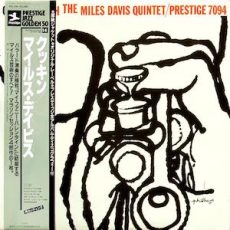
Requisites
Cookin’ With The Miles Davis Quintet ~ The Miles Davis Quintet | By Eddie Carter
This morning’s choice from the library is the first of four albums Miles Davis recorded to complete his contract obligations with Prestige before moving on to Columbia Records. It took only two days for all four to be made but resulted in Relaxin’ (1958), Workin’ (1959), Steamin’ (1961), and Cookin’ With The Miles Davis Quintet (Prestige PRLP 7094), released in 1957. The group consists of Miles Davis (track: A1) on muted trumpet, (tracks: A2, B1, B2) on trumpet, John Coltrane (tracks: A2, B1, B2) on tenor sax, Red Garland on piano, Paul Chambers on bass, and Philly Joe Jones on drums. My copy used in this report is the 1984 Prestige Jazz Golden 50 Series Japanese Mono reissue (Prestige SMJ-6534M) by Victor Musical Industries, Inc.
Side One begins with the date’s only quartet performance, a gorgeous rendition of My Funny Valentine by Richard Rodgers and Lorenz Hart. Red introduces the standard with a brief introduction, segueing into the trumpeter’s sublimely beautiful, muted melody over the rhythm section’s soft accompaniment. Miles then expresses his thoughts and feelings in a heartwarming performance. Red comes in with a compelling interpretation preceding the trumpet’s sensual beauty at the end. The quintet picks up the pace for an original by Miles, affording everyone solo space, Blues By Five. The trio introduces this tune with an infectious groove. Davis steps up first for a vivacious opening solo, next Coltrane follows with a swinging statement. Garland creates a mood of cheerfulness in the third reading, then Chambers makes a strong impression next. Philly shares an intriguing conversation with Garland who leads the trio to the finish line.
Side Two starts at a fast clip with a speedy rendition of Airegin by Sonny Rollins. John opens with a lively introduction that sets the tone for the ensemble’s vigorous melody. Miles kicks off the solos with fierce intensity, then John fuels the second statement with plenty of heat into the ensemble’s return for the reprise and abrupt stop. Tune-Up by Miles Davis opens with a brisk introduction by Philly ahead of the quintet’s spirited melody. Davis is captivating from the opening notes of his exhilarating reading. Coltrane comes next and surges upward toward the stratosphere. Garland gets a brief moment to shine, then Miles and Philly have a short exchange into the close. The quintet wraps the album with When Lights Are Low by Benny Carter and Spencer Williams. The solo order is Miles, Coltrane, and Garland. All three take their readings at a leisurely pace leading to the group’s exit and a brief word from Miles.
Bob Weinstock supervised the original session of Cookin’ With The Miles Davis Quintet, and Rudy Van Gelder was the recording engineer. The remastering of his tapes by Victor Musical Industries is outstanding, and this reissue is a sonic treat. The sound is spacious, natural, and well-balanced. The vinyl is dead silent until the music starts and each track on this album and its companions were all done in just one take. If you’ve listened to or own any of the other three records in this series, get ready to like Cookin’ With The Miles Davis Quintet just as much. I highly recommend this album to anyone who loves jazz and is a fan of Miles Davis’s work during the fifties. This version of the quintet lasted just two years, but they made an indelible impression by creating music that can be played repeatedly and enjoyed endlessly!
~ Relaxin’ With The Miles Davis Quintet (Prestige PRLP 7129), Steamin’ With The Miles Davis Quintet (Prestige PRLP 7200), Workin’ With The Miles Davis Quintet (Prestige PRLP 7166) – Source: Discogs.com ~ My Funny Valentine – Source: JazzStandards.com © 2022 by Edward Thomas Carter
More Posts: choice,classic,collectible,collector,history,instrumental,jazz,music,trumpet
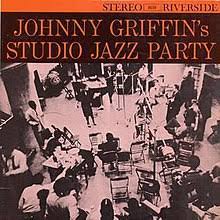
Requisites
Johnny Griffin’s Studio Jazz Party ~ Johnny Griffin | Eddie Carter
This title from the library brings renown jazzman Johnny Griffin into the spotlight for his only live album as a leader on Riverside Records. Submitted now for your approval is the 1961 LP, Johnny Griffin’s Studio Jazz Party (RLP-9338), recorded before a live audience that was invited to the recording session inside Plaza Sounds Studios. Joining the saxophonist are Dave Burns on trumpet; Norman Simmons on piano; Victor Sproles on bass and Ben Riley on drums. My copy is The Riverside Original Recording Series Japanese Stereo reissue (SMJ-6145), released in 1976 by Victor Musical Industries, Inc.
The performance is hosted by Babs Gonzales who welcomes the crowd to the session on the opening track, Party Time and introduces the first song, Good Bait by Count Basie and Tadd Dameron. This standard was written in 1944, becoming a feature in Basie’s and Dizzy Gillespie’s Orchestra. Griffin and the trio introduce the song slowly, picking up immensely when the melody moves to a medium-fast tempo. Dave sets the pattern for the song on the opening statement with punchy rhythms, crisp lines, and a crackling tone. Simmons strolls into the next reading for an impressive interpretation which shows no strain as each phrase unfolds. Both horns share a few more statements before the ensemble returns for a march-like closing chorus and amusing ending.
The first side ends on an uptempo note with the 1942 popular song, There Will Never Be Another You, written by Harry Warren and Mack Gordon for the musical film Iceland, which premiered that same year. The first recording outside the film was a 78-rpm single (B-11574) by vocalist Joan Merrill recorded for the RCA subsidiary, Bluebird. The trio opens with an abridged introduction, stepping aside as Burns begins the opening chorus and the lead solo ambitiously with a drive which generates its own excitement. Simmons is dazzling on the next reading with choruses which illustrate a mature sound that swings freely. Griffin romps through the next statement of this cheery bouncer with long, flowing lines that are rewarding in every respect to the delight of one fan who urges him on as his solo progresses. Sproles is up next to give a brief statement with an agility that shows he is much more than a solid foundation and sets up the front line to share a few final thoughts before the ensemble brings the song to a close to the delight of the crowd.
Babs opens the second side with a message to the crowd, then the group tears into Dave Burns’ Toe-Tappin” which possesses great speed from the start and the interaction between the front line during the main theme is marvelous. Dave kicks off the lead solo with a passionate presentation which launches its own fireworks in perfect harmony on each note to the equally incandescent foundation by the rhythm section. Norman sustains the ferocious pace with a knockout performance on the next statement, then Johnny charges ahead with enthusiastic phrases on the tune’s longest interpretation which are constructed marvelously. Victor fuels the final reading with pure adrenalin for an exclamation point that will have your fingers popping and your toes tapping to the contagious beat until the quintet’s soft fade finale and audience’s fervent expression of approval.
The LP’s only standard is a classic from The Great American Songbook which Babs introduces in French. You’ve Changed was written in 1942 by Carl Fischer and Bill Carey and has been covered by many vocalists in the jazz and pop genres. The definitive vocal of this popular song, in my opinion, was sung by Billie Holiday on the 1958 Columbia album, Lady In Satin (CL 1157/CS 8048). After a brief introduction by the trio, Burns plays the first half of the opening chorus with Johnny playing the second half to ng, amiable final presentation that leads back to the closing chorus and a gentle ending as the applause fades to mark the end of this very enjoyable Studio Jazz Party.
The original recording was engineered by Ray Fowler, the man behind some of the greatest jazz albums on Riverside and Jazzland with the mastering done by Jack Matthews of Components Corporation for this Japanese LP. Both men have done their job well because the sound is vivid with each instrument providing a realistic soundstage that surrounds your sweet spot, placing you in the best seat to enjoy the performance along with the crowd. The music which makes up the program is equally enjoyable, and I even found Gonzales’ comments throughout the album colorful and its crystal-clear Babs was in a party mood as the set progressed. In short, Johnny Griffin’s Studio Jazz Party is a pleasurable program of music which still stands up well nearly six decades later and at nearly forty-six minutes, offers a benefit to the novice or knowledgeable listener that he or she will get their money’s worth from a performance they can revisit anytime.
~ Good Bait, There Will Never Be Another You, You’ve Changed – Source: JazzStandards.com, Wikipedia.org © 2020 by Edward Thomas Carter
More Posts: choice,classic,collectible,collector,history,instrumental,jazz,music,saxophone


